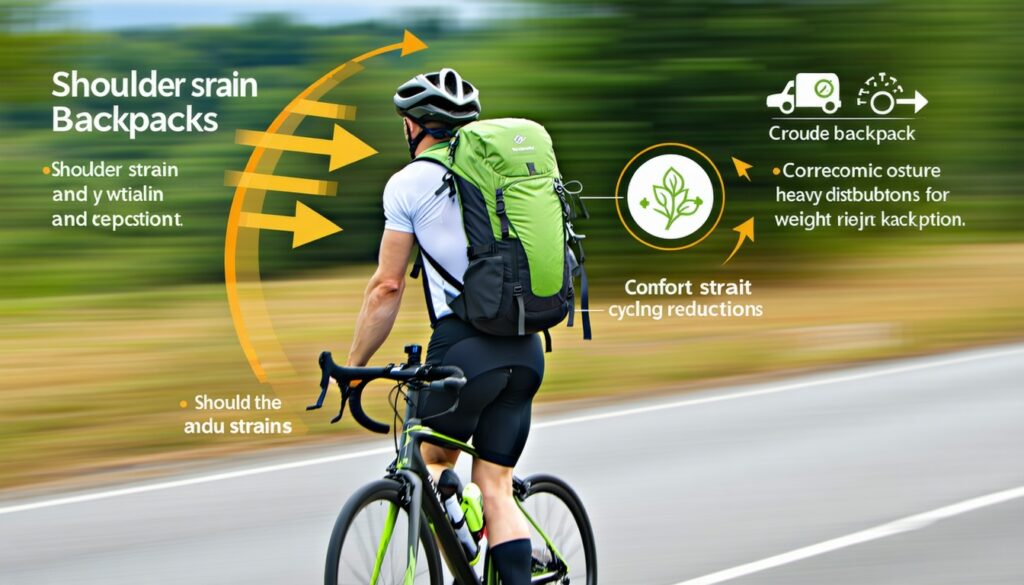How to Avoid Shoulder Strain with Heavy Cycling Backpacks

Shoulder Strain Prevention Tips
Cyclists of all ages can benefit from taking precautions against shoulder strain when using heavy cycling backpacks. Proper backpack positioning and effective load distribution are essential for a comfortable ride.
Proper Backpack Positioning
Properly positioning a backpack can significantly reduce the risk of shoulder strain. A wider strap placement on the shoulders helps alleviate neck and upper back pain by spreading the load further apart. This approach eases stress on neck muscles and reduces the workload on the upper trapezius and levator scapulae.
Wearing the backpack lower on the back is especially beneficial when carrying heavier loads. Loosening the shoulder straps can allow the load to sit closer to the lower back, enhancing stability. This position helps the load pull down and back on the shoulders, improving overall posture while cycling.
In terms of load distribution, using chest and hip straps can aid in balancing weight on both shoulders symmetrically. This setup minimizes muscle strain, nerve irritation, and limits blood circulation issues. A backpack positioned lower on the back, closer to the center of gravity, is essential for preventing low back strain during rides (Cycling West).
| Positioning Tip | Benefit |
|---|---|
| Wider strap placement | Reduces neck and upper back pain |
| Lower positioning | Enhances stability and improves posture |
| Use of chest and hip straps | Distributes weight, minimizes strain |
Spreading Load Effectively
Spreading the load effectively across the backpack can enhance comfort and stability while cycling. Well-padded shoulder straps help in distributing weight evenly, which is essential for all-day use. Adjustable sternum straps and waist belts not only secure the pack, but they also prevent it from shifting during the ride.
Smart packing techniques play a crucial role in load management. Heavier items should be placed close to the spine and centered between the shoulder blades. This configuration maintains the body’s natural center of gravity and helps prevent awkward postures. Avoiding overuse of specific muscle groups can safeguard against back and shoulder pain while cycling.
| Packing Tip | Recommendation |
|---|---|
| Heavier items | Place close to the spine |
| Centered weight | Maintain natural center of gravity |
| Secure straps | Use adjustable sternum and waist belts |
By implementing these positioning and packing strategies, cyclists can significantly reduce the risk of shoulder strain, allowing for a more enjoyable cycling experience. For further guidance on choosing the right backpack for comfort and posture, refer to our article on how to choose an ergonomic cycling backpack for comfort and posture.
Choosing the Right Cycling Backpack
Selecting the right cycling backpack is essential for comfort and convenience while riding. This section covers key features to look for, including ventilation, padding, organization, visibility, and durability.
Ventilation and Breathability
When cycling, maintaining airflow is crucial to keep the rider comfortable and minimize sweat. Look for backpacks that feature airflow channels in the back panel and breathable shoulder straps, as these can help reduce sweat patches during daily rides.
| Feature | Benefits |
|---|---|
| Airflow Channels | Enhance ventilation and comfort |
| Breathable Straps | Minimize sweat accumulation |
A well-ventilated backpack can significantly improve the riding experience, especially on warmer days.
Padding and Strap Design
Proper padding and thoughtfully designed straps are vital for comfort and stability. Backpacks should have sufficient padding to support daily loads, while wide shoulder straps help distribute weight effectively. Features such as adjustable sternum straps and hip belts can secure the pack and prevent it from shifting during the ride.
| Padding Type | Advantages |
|---|---|
| Well-Padded Straps | Comfort during long rides |
| Adjustable Straps | Customizable fit for stability |
Using a backpack with appropriate padding can minimize shoulder strain, which is crucial for those concerned about how to avoid shoulder strain with heavy cycling backpacks.
Organization and Compartmentalization
A well-organized backpack allows cyclists to easily access their gear. Look for packs with multiple compartments or pockets to separate items such as tools, clothing, and snacks. This organization helps distribute weight evenly and simplifies packing.
| Compartment Type | Purpose |
|---|---|
| Main Compartment | For larger items and tools |
| Side Pockets | For water bottles and snacks |
Effective organization can save time and hassle during rides, especially on longer journeys or bikepacking trips. For additional insights, visit our guide on how to pack tools, snacks, and gear in a bike backpack.
Visibility and Safety Features
Visibility is essential for cyclists, especially during early morning or late evening rides. Choosing a backpack with reflective strips or bright colors can enhance safety by making cyclists more visible to motorists.
| Feature | Benefit |
|---|---|
| Reflective Strips | Improve visibility in low light |
| Bright Colors | Increase safety during rides |
Making informed choices regarding visibility features can significantly enhance a cyclist’s safety while on the road. For more tips on maintaining visibility, explore our article on reflective features that improve cycling visibility.
Durability and Weather Resistance
Durability is key in selecting a cycling backpack, particularly for daily commutes. Look for packs made from quality materials that offer lasting construction and weather-resistant features, such as water-repellent zippers and seam-welded seams. This ensures that the contents remain dry and protected during unexpected weather changes.
| Material | Benefits |
|---|---|
| Water-Repellent | Protects from rain and moisture |
| Seam-Welded | Enhances durability |
By choosing a cycling backpack with excellent durability and weather resistance, riders can feel confident that their gear stays safe in all conditions. For more on the differences in weather protection, read our guide on waterproof vs water-resistant: choosing bike-safe backpacks.
Selecting the right cycling backpack that features ventilation, padding, organization, visibility, and durability can greatly enhance the cycling experience while also helping to prevent shoulder strain during rides.
Backpack Fitting and Adjustment
Proper fitting and adjustments of a cycling backpack are essential for preventing shoulder strain and enhancing the overall cycling experience. By focusing on ergonomic fit and smart packing techniques, cyclists can maintain comfort and efficiency while on the road.
Importance of Ergonomic Fit
An ergonomic backpack fit is crucial for maintaining proper posture and avoiding pain in the back and shoulders. To achieve this, several steps should be followed:
- Measure Torso Length: The first step is to measure the torso length to ensure the backpack rests comfortably on the body.
- Adjust Shoulder Straps: Straps should be snug to provide support without constricting movement. It is important that they do not dig into the shoulders.
- Utilize Load Lifters: Load lifters help bring the weight of the backpack closer to the back, enhancing stability and balance while cycling.
Smart Packing Techniques
Smart packing techniques play a significant role in preventing shoulder strain. Here are some effective strategies to consider:
-
Weight Distribution: Heavier items should be packed close to the spine and centered between the shoulder blades. This positioning maintains the body’s natural center of gravity and helps prevent awkward postures.
-
Comfortable Padding and Straps: Proper padding and wide shoulder straps help distribute the load across the back, enhancing comfort and stability.
-
Adjustable Straps: Utilizing adjustable sternum straps and waist belts secures the backpack and prevents it from shifting during rides. This adds layer of stability to the overall fit.
By adopting these ergonomic fitting practices and smart packing techniques, cyclists can minimize the risk of shoulder strain and enjoy a more comfortable ride. For more advice on choosing the best cycling backpack based on personal needs, explore our guide on how to choose an ergonomic cycling backpack for comfort and posture.
Shoulder Strain Management
Managing shoulder strain while using heavy cycling backpacks is crucial for cyclists of all ages. Through conditioning exercises and maintaining proper posture, cyclists can significantly reduce their risk of discomfort.
Conditioning and Strengthening Exercises
Conditioning the body helps cyclists build strength, flexibility, and balance, which are essential for supporting the shoulders and reducing strain. Engaging in routines that target the core, back, and shoulder muscles can improve overall cycling performance and comfort. Recommended exercises include:
- Core Strengthening: Planks, bridges, and other core exercises help stabilize the body during cycling.
- Shoulder Strengthening: Shoulder presses, lateral raises, and rows can build shoulder muscle strength.
- Flexibility Exercises: Incorporating yoga or Pilates can enhance flexibility and balance, reducing the likelihood of injury.
| Exercise Type | Benefits |
|---|---|
| Core Exercises | Stabilizes the body during cycling |
| Shoulder Exercises | Builds shoulder strength |
| Flexibility Routines | Reduces risk of injury |
Following a structured conditioning routine can help cyclists avoid shoulder strain. For tips on how to train with extra weight in a cycling backpack, check out our guide.
Importance of Correct Posture
Maintaining an ergonomic fit while cycling is essential for preventing shoulder strain. Proper posture allows strong shoulder muscles to engage effectively. Key elements include:
- Backpack Fit: Ensure that the backpack is appropriately fitted to the body. The hip belt should carry most of the load, thereby reducing the weight on the shoulders.
- Shoulder and Strap Adjustment: Shoulder straps should be snug yet comfortable, distributing weight evenly. Load lifters can be adjusted to improve stability, further minimizing strain on the back and shoulders.
Correct posture involves sitting upright with shoulders relaxed and avoiding positions that can lead to discomfort. Suitable clothing choices, such as quickly drying cycling gear and windbreakers, can also help keep shoulders warm and reduce muscle cramping.
For more information about how to choose a cycling backpack that promotes comfort and good posture, visit our article on how to choose an ergonomic cycling backpack for comfort and posture.
Backpack Alternatives for Cyclists
Panniers for Bike Racks
Panniers are an excellent alternative for cyclists seeking to reduce shoulder strain caused by heavy backpacks. These bags attach to bicycle racks, effectively redistributing the load from the cyclist’s body to the bike itself. This system alleviates stress and strain on the shoulders, leading to improved trunk and neck movement.
Here are some advantages of using panniers:
| Benefit | Explanation |
|---|---|
| Weight Distribution | By placing the load on the bike, cyclists can ride more comfortably. |
| Stability | Panniers maintain balance, preventing the shifting of weight that can occur with backpacks. |
| Versatility | Many panniers come with multiple compartments, making it easier to organize items. |
Panniers can be especially useful for long rides or bike commuting, as they allow cyclists to carry more without the discomfort associated with wearing a heavy backpack. However, it is essential to note that not all bicycles come with the necessary racks for panniers. Cyclists are encouraged to consult their local bike shop for advice on compatibility and installation.
For more information on how to choose the right cycling luggage, check our article on how to choose an ergonomic cycling backpack for comfort and posture.
Shoulder Pain Factors to Consider
Cycling with a heavy backpack can lead to shoulder strain. Understanding the anatomical and physical factors that contribute to this discomfort is crucial for cyclists of all ages.
Structural Differences in Shoulder Joints
The shoulder joint is uniquely structured compared to the hip joint. Unlike the hip, which is surrounded by a socket, the shoulder joint’s head is pulled against an undersized surface. This structure makes it more vulnerable to pain and injury, particularly in individuals with less muscle mass and stability. Women, who typically have less muscle mass, should pay special attention to their training and conditioning to help minimize shoulder issues while cycling.
| Factor | Details |
|---|---|
| Joint Structure | Head of shoulder joint against an undersized surface |
| Vulnerability | Higher risk of pain and injury without proper muscle support |
| Gender Considerations | Women generally have less muscle mass, increasing risk |
The Impact of Weight on Musculoskeletal Discomfort
Carrying excessive weight can lead to musculoskeletal discomfort. Research indicates that carrying as little as 10% of body weight in a backpack can affect skin blood flow and cause strain on the shoulders, neck, and back while commuting. In fact, the weight of the backpack is strongly correlated with shoulder, neck, back, and extremity pain, particularly in students. While several factors contribute to these discomforts, the carriage of a heavy backpack is a significant one.
| Weight Percentage | Effect on Body |
|---|---|
| 10% of body weight | It can occlude skin blood flow, causing strain |
| Backpack Weight | Direct correlation with shoulder and neck discomfort |
To further alleviate shoulder strain when using heavy cycling backpacks, it’s essential to implement strategies such as choosing an ergonomic backpack design. For guidance on this, explore our article on how to choose an ergonomic cycling backpack for comfort and posture.
Ergonomics for Pain-Free Cycling
Strategic Clothing Choices
Choosing the right clothing can make a significant difference when it comes to preventing shoulder strain while cycling. It is beneficial to wear gear made of synthetic fibers that dries quickly and provides adequate insulation. Such clothing helps keep the shoulders warm and prevents them from cooling down too rapidly, which can lead to muscle cramping and strain in the shoulder area. It’s advisable to look for lightweight windbreakers that offer protection without adding bulk. For additional tips on cycling gear, explore our guide on how to choose an ergonomic cycling backpack for comfort and posture.
| Clothing Type | Key Benefits |
|---|---|
| Synthetic Fibers | Quick drying, keeps muscles warm |
| Windbreakers | Protects against cold winds |
| Compression Gear | Supports muscles, reduces fatigue |
Handlebar Position and Grip Variations
Adjusting the handlebar position and varying grip can significantly help mitigate shoulder strain during cycling. Cyclists should frequently change hand positions on the handlebars. This helps to distribute pressure and gives the shoulders a break. It is essential to pay attention to several factors:
- Handlebar Width: A Proper width that complements shoulder width can reduce strain.
- Upper Body Inclination: Maintaining a slight lean can relieve stress on the shoulders.
- Handlebar Shape: Choosing the right shape can make gripping more comfortable.
- Seating Position: Proper seat height and placement ensure alignment that minimizes strain.
- Head Position: Keeping the head aligned can prevent unnecessary tension.
- Pelvic Position: Ensuring a balanced stance can help with overall posture.
Incorrect posture, such as locked elbows, can lead to direct pressure on the shoulders. Cyclists are encouraged to maintain an ergonomic position while riding to minimize discomfort. Regularly getting out of the saddle provides a chance to reposition and redistribute weight, further helping to alleviate shoulder strain. For more tips on maintaining comfort while cycling, see our article on how sternum and waist straps improve stability on the bike.
By focusing on appropriate clothing choices and handlebar adjustments, cyclists can enhance their riding experience while reducing the risk of shoulder discomfort.
Adjusting Mountain Bike Backpacks
Proper adjustment of mountain bike backpacks is essential for comfort and safety while cycling. This section highlights key considerations to avoid tension and chafing, ensure proper back length and alignment, and achieve ideal hip belt and shoulder strap positioning.
Avoiding Tension and Chafing
A poorly fitted backpack can lead to tension and chafing, affecting a cyclist’s ability to maneuver and increasing the risk of injury. Properly adjusting the straps and positioning of the backpack is vital.
| Issue | Cause | Solution |
|---|---|---|
| Tension and Chafing | Incorrect adjustment of straps | Loosen or adjust straps properly |
| Restricted Movement | Excessive weight on shoulder straps | Shift weight to the hip belt |
| Movement Restriction | Poor fit causing the backpack to shift | Adjust the fit to the body’s contours |
Incorrectly adjusted packs can create pressure on shoulder muscles, forcing cyclists into unnatural positions. Adjusting the pack can significantly reduce this strain.
Proper Back Length and Alignment
To ensure a perfect fit, it’s crucial to adjust the back length of the mountain bike backpack. Here are the steps for proper adjustment:
- Loosen All Straps: Start with all straps loosened to allow for easy adjustments.
- Align the Backpack: Press the Velcro surfaces firmly against each other to secure the pack.
- Fit to Body Contours: Adjust the flexible aluminum rail (if equipped) to follow the natural shape of the back for optimal alignment.
A well-aligned backpack will improve weight distribution and comfort during rides.
Ideal Hip Belt and Shoulder Strap Positioning
The hip belt and shoulder straps play a crucial role in distributing weight effectively. For proper positioning:
- Hip Belt: The hip belt should sit on the back two-thirds of its width above and one-third below the upper edge of the pelvis. It should be tight enough to support the pack’s weight without restricting pedaling movement.
- Shoulder Straps: Shoulder straps should carry minimal load, allowing for full upper body and shoulder movement. They should be adjusted to prevent shifting and provide stability.
This configuration ensures that the majority of the weight is supported by the hips, decreasing strain on the shoulders.
Finding the right adjustments can significantly enhance the cycling experience and help avoid shoulder strain associated with heavy cycling backpacks. For more tips on loading and packing your gear, check out our resources on how to pack tools, snacks, and gear in a bike backpack how to pack tools snacks and gear in a bike backpack.


